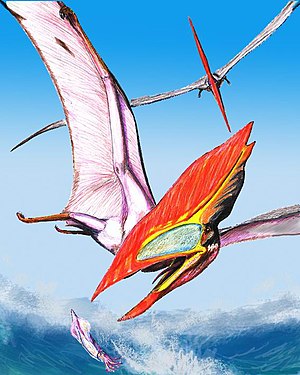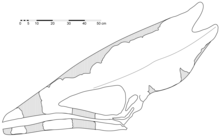Thalassodromeus
| Thalassodromeus | ||||||||||||
|---|---|---|---|---|---|---|---|---|---|---|---|---|

Thalassodromeus sethi , older graphic reconstruction of the animal while fishing in flight |
||||||||||||
| Temporal occurrence | ||||||||||||
| Albium to Cenomanium (Lower to Upper Cretaceous ) | ||||||||||||
| 112 to 93.5 million years | ||||||||||||
| Locations | ||||||||||||
|
||||||||||||
| Systematics | ||||||||||||
|
||||||||||||
| Scientific name | ||||||||||||
| Thalassodromeus | ||||||||||||
| Kellner & Campos , 2002 |
Thalassodromeus (Greek "sea creeper", species T. sethi named after the Egyptian sea god Seth ) is a genus of large pterosaurs from the Lower Cretaceous of Brazil . Their representatives lived about 112 to 94 million years ago. T. sethi is the type species and at the same time the only scientifically described species of the genus.
Thalassodromeus was first scientifically described in 2002 by Alexander WA Kellner and Diogenes de Almedia Campos on the basis of a skull from the Santana Formation, which is known for its rich fossil vertebrate fauna .
The skull is lengthened to 142 centimeters by a huge bone crest . This comb probably had additional extensions made of keratin which must have made the head even bigger and heavier in the living animal. Thalassodromeus sethi had an estimated wingspan of about 5.30 meters.
Lifestyle and diet
For a long time it was assumed that Thalassodromeus was fed by swimming marine animals, comparable to recent scissor beaks . This assumption , however, was now outdated, and scientists now assume that the genus is mainly fed on smaller land animals. The animal's curved beak shows the ability to withstand wild, unpredictable forces, such as those caused by a captured prey in agony, but does not have the characteristics necessary for fishing in flight. The pterosaur would have been comparable to today's secretary or to extinct species of terror birds . The large head comb was probably used for communicative activities such as warning and for intersexual selection through sensory bias .
literature
- Alexander WA Kellner, Diogenes de Almeida Campos: The Function of the Cranial Crest and Jaws of a Unique Pterosaur from the Early Cretaceous of Brazil. In: Science . Vol. 297, No. 5580, 2002, pp. 389-392, doi: 10.1126 / science.1073186 .
Individual evidence
- ↑ Liza Gross: A New View of Pterosaur Feeding Habits. In: PLOS Biology . Vol. 5, No. 8, 2007, e217, doi: 10.1371 / journal.pbio.0050217 .
- ↑ Mark Witton: Mark Witton.com Blog: The appearance and lifestyle of Thalassodromeus sethi, supercrested pterosaur. In: Mark Witton.com Blog. October 11, 2017, accessed April 1, 2019 .
Web links
- National Geographic News (English)


